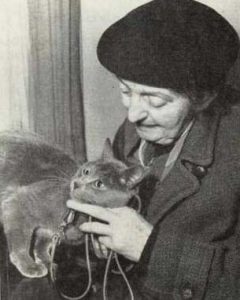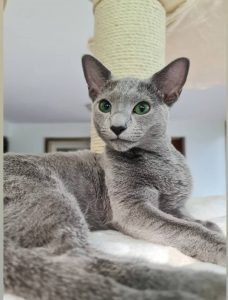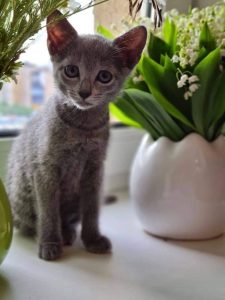History of Russian Blue
The origins of the Russian Blue are mysterious, but the most popular theories place the breed’s birthplace in Northern Russia’s Archangel Islands.

Some cat historians hold that russian blue has royal blood, descending from the beloved pets of czars. Others suggest that the breed’s dense, beautiful coat would’ve made it a prized target of hunters out in the wild. That thick coat certainly supports the idea that the breed originated in a cold climate like Russia’s. Russian blue cat was first time mentioned in the VIII. century. At that time, this breed of cats was found in the northern parts of Finland, Russia and Norway. Because of the gorgeous, beautiful color, the coat of Russian blue cats was used by northern peoples for sewing warm gloves and capes. But gradually the attitude towards these extraordinary animals changed for the better. They became pets of the Russian people, and according to Slavic traditions, these cats were trusted to keep babies sleeping, keeping away evil spirits from them. So for many centuries, these cats lived with people and were considered common pets. In 1901. this cat breed received official recognition. And in 1912. in Great Britain they began to recognize Russian blue cats as a separate breed, calling them foreign blue cats. Then, in 1930., an association of lovers of the Russian blue cat was formed. After the Second World War, there were practically no representatives of this breed of cats. Only thanks to the work of connoisseurs, using the remaining genetic material and crossing this breed with others, it was possible to save the Russian blue cats from complete extinction. It was possible to restore the full compliance of blue cats with the original data many years later, in 1972.
About Breed
Russian blue cats are medium to large size. They have a graceful body and long, elegant legs. The neck is straight and long. This cat is so graceful that sometimes it seems like she is walking on tiptoe.

The head is wedge-shaped with excellent straight profile and large ears.
The bright green eyes are set wide and almond-shaped. Particular attention is paid to the purity of the color of the eyes; they should have a rich green color without interspersed with yellow spots on the irises.
The ears are vertical and large, widening towards the bottom, with pointed tips. On the inner side of the ears, hair is usually almost completely absent.
The limbs should be long with round oval legs. Long tail without knots and breaks, tapering towards the end.
The texture of the Russian blue coat is completly different then the one from other breeds, and this is the main distinguishing feature of the breed. The coat of these animals is double, with a thick undercoat, short and extremly pleasant to the touch. Top coat is equal length and delicate texture. The fur should not fit snugly to the body.
Despite the name of the breed, sometimes among the Russian blue cats there are individuals with black and white colors. In typical representatives, the color is uniformly blue, with a silvery shade. Stripes and spots in the coat color are considered a defect.
Temperament
By nature, the blue Russian cat is independent, but obedient, it will not break your daily routine and the rules. Russian blue cats are real empaths: they subtly feel the mood of the owner and adapt to it. They are quiet, reserved intellectuals, very carefull to new people and do not show feelings to the first comer. They have periods of activity during which the cat jogs, jumps from a height, and demands attention vigorously, but don’t worry, they will not pursue you and demand constant attention to themselves. Their big, warm heart will treat all family members with affection and warmth. Russian blue cats are suitable for children any age. They easily adapt to any living conditions, get used to all family members and other pets. Their intelligence, curiosity and mobility are in tune with their love to owner. They tolerate traveling by car much better than being alone in the confined space of an empty apartment. These are neat graceful cats that will not ruin your furniture, break dishes and repeat the same mistakes, because they are very smart and will understand the rules you have set almost immediatly.
Health
The Russian blue cats have very good health if living in good conditions and have proper care and food.
Care and Grooming
The Russian blue cat is unpretentious in grooming. To keep the cat’s coat in good condition, it needs to be combed out about once a week, and every day during the moulting period. You can also to wash your cat occasionally using dry shampoo or normal with some gentle shampoo and conditioner for smoothing. You should trim the claws about 1 time per month to make sure that the claws do not interfere with the free movement of this graceful cat.
Food
Nutrition is the most important to provide your cat long and happy life. If the cat does not receive the required amount of vitamins and minerals, health problems will appear and its appearance will deteriorate. We use combination of raw and premium/ super premium ready-made feeds. This provides a complete diet for our kittens and cats.
Living with Russian Blue
Russian blues are good climbers and jumpers and should have cat trees and perches.

The Russian blue is a sturdy, stocky cat and her nutrition should be watched to prevent obesity, particularly if the cat does not get enough exercise. It is better to place the bed for the cat higher – in a place where the animal will feel safe and have good view to all house.
While adult Russian blue are peaceful cats, they also tend to be very kittenish and love their daily playtime. They love being adored by their human parent, and love having their stomach rubbed and being petted. A daily petting session is a must for any Russian blue.
They like to be in the company of the owner, if the situation does not imply high activity. These cats make excellent companions.
Male and female Russian Blue can tend to be quite different. Females are very curious, active and emotional, while males are more relaxed and lazy.
Indoor Only
Russian blue cats are indoor only.
The most significant risk is being injured, killed by a vehicle or stollen, especially for young cats who haven’t learned the dangers of traffic and human. If they accidentally escape and become lost, these cats have less chance to survive on their own then domestic cats.
Other animals can prey on cats. Free walking dogs are the most common risk, and your local vet can testify to the horrendous injuries cats suffer when they’re bailed up by dogs.
Free-roaming cats who catch mice and rats that have eaten poison baits can become poisoned secondarily. Other things are also toxic to cats, such as lilies and anti-freeze, and some cats are maliciously poisoned.
In order to insure your russian blue cat long and happy life choose walking on leash instead let her walking alone and to put himself in danger.
Short Information
-Coat type : Shorthair
– Height: up to 25 cm
- The weight: 3-7 kg
- Average living age: 16–20 years old
-Russian blue is considered one of the smartest breeds
– Has amazing green eyes and elegant body
– Chooses one master and obeys only him
– Independent, graceful, aristocratic
